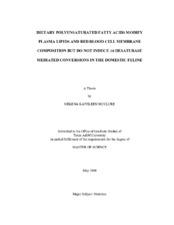| dc.description.abstract | This study explored the effects of dietary unsaturated fatty acids on feline lipid
metabolism. It was hypothesized that high dietary linoleic acid (18:2n-6, LA) would
enhance conversion to arachidonic acid (20:4n-6), enrichment of dietary long chain n-3
FA (LCn-3FA) would affect lipid parameters, and n-3 FAs incorporation may blunt n-6
FA incorporation. Twenty-nine cats were randomized into groups (n = 9, 10, 10), and
fed for 28 days with blood collections on days 0, 14, and 28. Experimental diets
consisted of a commercial diet, supplemented with 8g oil/100g kibble. Oil supplements
and subsequent diets were: high-oleic sunflower (H diet) with 82% oleic acid (18:1n-9),
Menhaden fish (M diet) with LCn-3FA, and safflower (S diet) with 75% 18:2n-6.
Dietary 20:4n-6 content was: 0.03 for H and S, and 0.09 for M (g FA/kg diet). Nonesterified
fatty acid (NEFA), triacylglycerol (TG), total cholesterol (TC), lipoproteincholesterol
(LP-C), plasma phospholipid (PL) FAs, red blood cell membrane (RBC)
FAs, and ∆5 and ∆6 desaturase indices were measured. Statistical analyses were
performed with SAS PROC MIXED with p < 0.05 determining significance. Neither TC nor NEFA showed significant effects. Diet M resulted in significant TG lowering,
despite typically low feline TGs. Similarly, pre-β LP-C (i.e. TG-rich VLDL) was
decreased in diet M. Plasma PL FAs revealed significant accumulations of the
following: 18:1n-9 in diet H, 18:2n-6 in diet S, and LCn-3FA in diet M. Despite high
dietary 18:2n-6, plasma PL 20:4n-6 was not increased in diet S over diets H or M.
Increased docosadienoic acid (20:2n-6) in diet S demonstrated that 18:2n-6 chain
elongation occurred in deference to its ∆6 desaturation further substantiating low feline
∆6 desaturase activity. Interestingly, no diet M blunting of 20:4n-6 incorporation
occurred because fish oil supplementation provided additional 20:4n-6. Tissue 20:4n-6
content appears to be diet-dependent. Accumulation of eicosapentaenoic acid (20:5n-3),
but low affinity for docosahexaenoic acid (22:6n-3) occurred in diet M RBC membranes.
After 28 days, plasma PLs reflect dietary intake more readily than RBC membranes.
Fish oil supplementation resulted in plasma PL LCn-3FA enrichment and lowered
plasma TG concentrations, both of which may have physiological significance in cats. | en |


